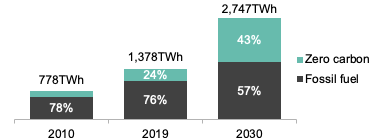New Report Presents India’s Clean Energy Progress as a Model for Cleaner Economic Growth and Recovery Following COVID-19
“India’s Clean Power Revolution” report by BloombergNEF and Bloomberg Philanthropies shows how India has become a thriving clean energy market, and how it can achieve its renewable power target of 450GW by 2030, the most ambitious in the world
Read the full report here.
NEW YORK AND NEW DELHI — Today, Bloomberg Philanthropies and BloombergNEF (BNEF) released “India’s Clean Power Revolution,” a new white paper detailing how India has become the world’s largest and most competitive clean energy auction market – and a model country for others looking to leverage low-carbon investments in their Covid-19 economic recovery strategy.
The report outlines how India’s rapid progress in sustainable economic growth and clean energy can be a model for nations looking to recover from the Covid-19 pandemic through the adoption of green stimuli that maximize economic, health, and environmental benefits. Produced in partnership with Bloomberg Philanthropies, the BNEF report builds on Bloomberg’s ongoing commitment to tackle climate change and the air pollution crisis by moving the world to a clean energy economy.
India is currently ranked as the top emerging market for clean energy investment by BNEF’s Climatescope. This reflects the comprehensive set of enabling policies introduced by its government to meet a goal of 450GW clean energy by 2030, its openness to investors, and the volume of renewables auctioned in recent years.
“Governments around the world are working to strengthen national economies after the devastation of the coronavirus. If we act wisely, the response to this crisis can also be a turning point in the battle against the climate crisis,” said Michael Bloomberg, founder of Bloomberg L.P. and Bloomberg Philanthropies. “Investment in clean energy goes hand in hand with economic growth. India is a great example of that, and with its ambitious goals for the years ahead, India’s policies have helped to make it the number one ranked emerging market for clean energy investment.”
In an interview with BNEF, to be released at 16:15pm (IST) today, Shri Raj Kumar, Union Minister of State (Independent Charge), Ministry of Power and Ministry of New and Renewable Energy and Minister of State, Ministry of Skill Development and Entrepreneurship, India, talks about the government’s aim to sharply lift the proportion of India’s electricity that comes from non-fossil fuel sources by 2030: “India pledged in Paris that by 2030, 40% of our installed capacity will be from green sources, non-fossil-fuel based resources. By 2030, the energy from non-fossil-fuel sources will be 55-60%.”
He will also say: “The question before us as a country, and as the world, is whether the environment is important or not, and whether we want to leave behind a livable world for our great grandchildren.”
Launched at the BNEF Summit New Delhi: Strategic Briefing and Dialogue “India’s Clean Power Revolution” outlines how India’s competitive renewables market and ambitious clean power goals are projected to double the share of zero-carbon electricity generated in the country over the next decade. Thanks to the competitiveness of renewables, attaining these goals would save over $78 billion in power system costs and avoid 2,860 million tons of CO2 emissions, improving air quality and reducing respiratory illnesses and early deaths across the country.
The transition represents a $410 billion investment opportunity in new power generation capacity, whilst $223 billion of investment in transmission and distribution infrastructure will be needed to accompany this growth.
India’s success in creating a vibrant clean energy market provides a range of lessons for both developed and developing economies looking to leverage renewables and reduce power procurement costs. Solar and wind have been the cheapest sources of bulk power generation in India since 2018.
“India is hugely important for the world’s economic growth and development, and equally important for global progress in the fight against climate change. This report highlights India’s unique innovations in decarbonization, and the policies it is putting forward as good examples for other countries,” said Jon Moore, CEO of BNEF.
Figure 1: India’s electricity demand and generation mix, 2010-2030

Source: BloombergNEF’s New Energy Outlook 2019
About Bloomberg Philanthropies
Bloomberg Philanthropies invests in more than 570 cities and over 160 countries around the world to ensure better, longer lives for the greatest number of people. The organization focuses on five key areas for creating lasting change: the Arts, Education, Environment, Government Innovation and Public Health. Bloomberg Philanthropies encompasses all of Michael R. Bloomberg’s giving, including his foundation and personal philanthropy as well as Bloomberg Associates, a pro bono consultancy that works in cities around the world. In 2019, Bloomberg Philanthropies distributed $3.3 billion. For more information, please visit bloomberg.org or follow us on Facebook, Instagram, YouTube, Twitter, and TikTok.
About BloombergNEF
BloombergNEF (BNEF) is a leading provider of primary research on clean energy, advanced transport, digital industry, innovative materials, and commodities. With a team of experts spread across six continents, BNEF leverages the world’s most sophisticated data sets to create clear perspectives and in-depth forecasts that frame the financial, economic and policy implications of industry-transforming trends and technologies. Available online, on mobile and on the Terminal, BNEF is powered by Bloomberg’s global network of 19,000 employees in 176 locations, reporting 5,000 news stories a day.
Visit https://about.bnef.com/ or request more information.
Media Contacts
Daphne Wang
Bloomberg Philanthropies
+1-646-771-1473
daphne@bloomberg.org
Veronika Henze
BloombergNEF
+1-646-324-1596
vhenze@bloomberg.net